What is good about Spaghetti squash and why this variety will not leave you indifferent
All gardeners dream of growing an unusual crop. Spaghetti pumpkin, bred by North American breeders, is just like that. This unusual vegetable will not leave anyone indifferent. Today we will tell you how to grow it in your garden. In the article you will find interesting recipes for preparing dishes from the exotic variety of Spaghetti pumpkin.
Description and distinctive features of the variety
This crop is known as Pumpkin Squash, Spaghetti Squash, and Spaghetti Squash. The unusual variety got its name because of its similarity to boiled spaghetti. The pulp of the ripe orange fruit splits into thin fibers that are very similar to pasta. This is clearly visible in the photo below.
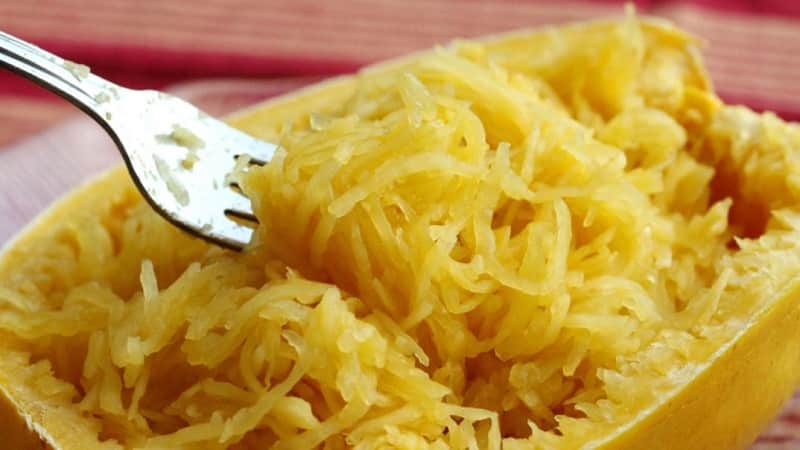
The seeds and pulp of Spaghetti have an uncharacteristic aroma for pumpkin. They don't smell like nutmeg or melon, and vanilla or walnuts.
In addition to its interesting appearance and unusual aroma of the pulp, this pumpkin has a low sugar content. 100 g of vegetable contains only 25 kcal.
Fruit characteristics and yield
The shape of the pumpkin is oblong, divided into segments, reminiscent of a melon. The color of the fruit is rich, from bright yellow to orange-red. The average weight of one pumpkin reaches 0.8-1.5 kg. The pulp of the orange vegetable when raw is dense, light yellow or beige in color.
The Spaghetti variety has a high yield - 10-15 kg/m². The vegetable bears fruit from the end of July until frost.
How to grow
If climatic conditions allow (sufficient moisture and heat), the seeds are sown immediately in open ground. But in cold climates, seedlings are first grown at home. This is done at the end of April - beginning of May. This period is the most favorable for sowing seedlings. The plant is planted in the ground in May-June. Planting pattern – 60 by 60 cm.
Seed preparation
Prepare before planting seeds. They are either purchased at a specialized store, or collected in the fall and prepared independently. Dry them only at room temperature, not in the oven. Store planting material in a thick cloth bag in a dry, dark place.
Before sowing, the seeds are sorted out and the empty ones are thrown away. Only large seeds are used. They are soaked in warm water and left overnight. Then wrap it in a thick damp cloth for 2-3 days. To speed up seed germination, it is periodically moistened with water. After germination, the planting material is placed in pots with soil or open ground.
Sowing
Gardeners recommend sowing pumpkin seeds in pots 20 days before planting in open ground (approximately in the second half of May). The pots are filled tightly with the substrate and watered abundantly. Then they make holes about 5 cm deep, sow the seeds and cover them with soil.
If planting material is sown not in pots one at a time, but in boxes or other large containers, it is recommended to add sawdust to the bottom. The layer thickness is about 4 cm. This allows the soil to retain moisture longer.
Priming
As for the soil itself, there are two types for pumpkin seeds. Namely:
- self-prepared: peat, humus, fine sawdust in a ratio of 1:2:1 and “Nitroammofoska” (1 tsp per 1 kg of soil);
- purchased at a gardening store (substrate for cucumbers or universal).
Growing seedlings
Almost any soil is suitable for the plant. You just need to periodically feed it with organic and potassium fertilizers. This is especially important for pumpkins grown in poor, dry soil.
Seedlings are quite fragile, so it is better to use special peat pots for growing, and then plant the plants directly in them in the garden. Pots for these purposes are taken at least 6x6 cm in size.
Care
Spaghetti is an unpretentious variety. Caring for it consists of loosening the soil and timely watering. It is also important to pinch the growing vines when 1-2 fruits are tied on them. Read more about caring for the Spaghetti pumpkin variety below.
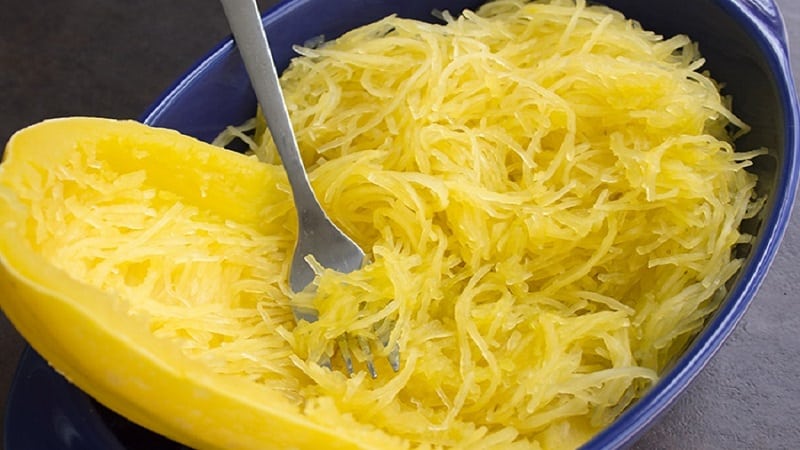
Watering
The Spaghetti variety is drought-resistant and easily tolerates the lack of moisture. But the yield depends on timely watering. Therefore, as the soil dries, it is moistened. Water the plant at the root, trying not to get it on the foliage. They do this in the evening.
Weeding
Pumpkin does not tolerate competitors - all weeds are removed in a timely manner. It is recommended to mulch the soil - cover the surface of the earth with straw or sawdust. Mulch will also help prevent overheating of the soil and retain moisture in it.
Loosening
It is important to prevent the formation of a crust on the surface of the soil. Otherwise, it will be difficult for oxygen and moisture to penetrate to the roots of the plant. To avoid this, the soil is periodically loosened and covered with mulching material.
Top dressing
Nutrient mixtures are used to fertilize Spaghetti pumpkin. Most often, the plant is fed during watering.
It is important to follow the feeding order:
- The first is carried out two weeks after planting the seedlings in the ground with wood ash - 1 liter per bucket of water.
- After a week, add diluted manure - 1 liter per 10 liters of water.
- In the summer, add 0.5 liters of nettle herbal infusion to each plant. First, the grass is crushed and filled with water for a week, and before use it is diluted again with water 1:10.
- Yeast feeding is used in the same way (1 liter for each plant): 100 g of yeast and 100 g of sugar are dissolved in 10 liters of water, and later the same amount of liquid is added to the solution.
- When the fruits begin to set, the plant is fertilized with a solution of superphosphate or potassium sulfate - 1 tsp per 5 liters of water. facilities.
Important! Pour fertilizer into the pre-moistened soil, moving 15-20 cm away from the roots.
Features of cultivation and possible difficulties
Spaghetti pumpkin is grown in the same way as any other pumpkin. But during formation, all the resulting lashes are left on the plant and 3-4 fruits are left on each of them.
The plant is constantly blooming. The stems grow rapidly and reach a length of up to 8 m. They bear a large number of fruits both on the central stem and on the side ones. If desired, the vine is formed by pinching the central stem or removing side shoots. They do this to limit its growth in a certain direction.
It is convenient to grow spaghetti on a trellis along which it will weave itself. The fruits hold tightly to the stem and do not require a special garter. Difficulties arise in cold, rainy summers. Fruits do not ripen in such weather conditions and subsequently rot during storage.
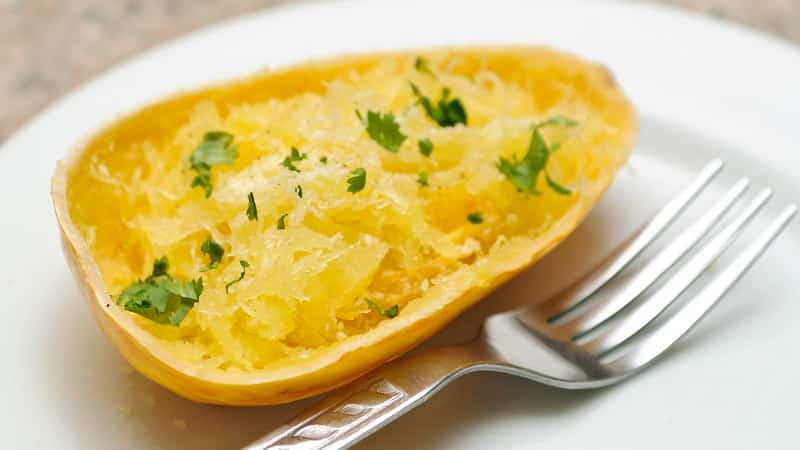
Diseases and pests
In rainy summers, powdery mildew may appear on the pumpkin. To prevent and treat this disease, the plant is treated with a 70% solution of colloidal sulfur.
In addition, the pumpkin suffers from bacteriosis, in which the leaves become stained and dry out. This disease is treated with a solution of copper sulfate (10 g per 5 liters of water and 20 g of urea). The dry substances are dissolved in a small amount of cool water and then brought to 40°C. Prepare a solution of copper sulfate in a non-metallic container. Spray twice with a break of a week.
Helps against ticks garlic tincture and onion peels.
Important! Young plants are watered and dusted with ash. It repels spider mites, slugs, whiteflies and aphids.
Harvesting and application
The first sign that it is time to harvest is the wilting of the green mass of the plant. If the summer was cold and the leaves do not dry, the harvest is harvested before the end of September. The fruits are perfectly stored in a dry, dark, cool place until spring.
Spaghetti pumpkin is used for baking, cooking and frying. People observing diet for weight loss, replace regular pasta with this vegetable. Young fruits are used in salads, like cucumbers or zucchini. They are added to porridges, various main courses, and desserts. Due to its low sugar content and low calorie content, this vegetable is suitable for dietary nutrition.
Advantages and disadvantages of the variety
The variety has many advantages. Spaghetti squash contains a huge amount of nutrients and antioxidants. And even with heat treatment, they are mostly preserved. And the peel of a ripe vegetable is characterized by increased hardness, so the pumpkin is stored until spring. People on a diet highlight this variety for its low sugar content.
For gardeners, the advantage of Spaghetti is its low maintenance. Unlike its large-fruited relatives, this vegetable is less demanding on heat, soil maintenance and watering. And with regular fertilizing with organic fertilizers, it gives a simply phenomenal harvest.
Among the disadvantages, vegetable growers note the susceptibility of pumpkin to various diseases. But it’s not difficult to deal with them, and it’s even easier to follow simple preventive measures.
The dish of the same name “Spaghetti Pumpkin”
Spaghetti squash is prepared in different ways. The finished dish is served with spices, butter, melted cheese, spaghetti sauce or other favorite sauce. Below you will find three ways to prepare the orange vegetable with step-by-step descriptions.
Boiled
Ingredients:
- 1 pumpkin;
- 2 tbsp. l. unsalted butter;
- 1 tsp. cinnamon;
- salt and pepper to taste.
Cooking process:
- Cut the pumpkin in half. Remove the seeds with a spoon and then cut the vegetable into small pieces about 7 cm long and 1.5-2 cm wide.
- Place the sticks in a large saucepan.
- Add water and let it boil over high heat.
- Simmer over low heat for 15-20 minutes. When the pumpkin is done, it will be soft. Check doneness with a fork.
- Drain the water and place the pumpkin on a plate.
- Season with salt, pepper and cinnamon. Add rosemary and nutmeg if desired.
- Place unsalted butter on hot squash until melted.
- Use a fork to scrape out the flesh to create “spaghetti.”
Baked in the oven
Ingredients:
- 1 pumpkin;
- 100 g Mozzarella cheese;
- spaghetti sauce;
- 2 tsp. dried basil;
- fresh herbs (parsley, cilantro, basil) optional.
Cooking process:
- Preheat the oven to 175 degrees. Cut the pumpkin in half and place the halves on a baking sheet, flesh side down.
- Pour a little water into the pan so that it covers the pan by 5-6 mm.
- Roast the squash for 40-45 minutes until tender. After 35 minutes, stick a fork into it and check for doneness. Remove the finished pumpkin from the oven.
- Scrape the pulp with a fork to create thread-like fibers, similar to spaghetti.
- Top the squash with mozzarella, spaghetti sauce and basil. Add bacon if desired and replace the Mozzarella with Parmesan.
- Place the pumpkin in the oven until the cheese begins to bubble. This will take another 3-5 minutes.
- Sprinkle the finished dish with finely chopped fresh herbs.
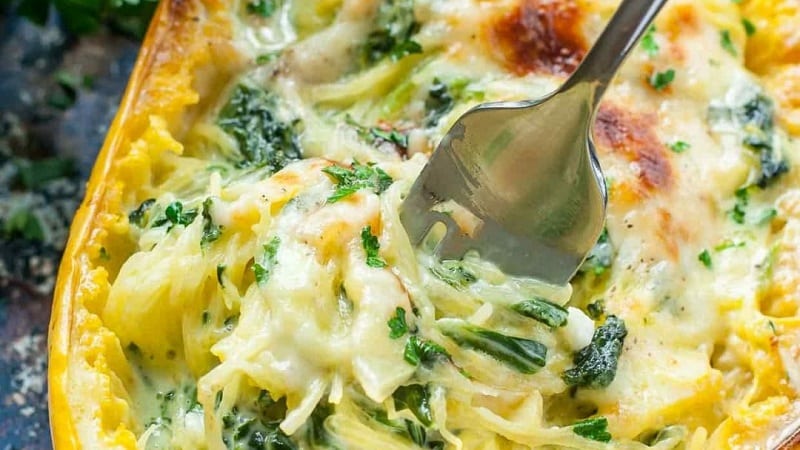
Microwave baked
Ingredients:
- 1 pumpkin;
- 3 tbsp. l. butter;
- 1/2 tsp. salt;
- 1/2 tbsp. l. pepper;
- 1/2 tsp. paprika.
Cooking process:
- Prepare the vegetable. Cut it lengthwise and then remove the seeds and fibers.
- Place a tablespoon of oil on each pumpkin half.
- Season with spices.
- Before putting the vegetable in the microwave, wrap it in film and pierce it in several places.
- Microwave for 20-25 minutes or until softened. Check the pumpkin for doneness with a fork – it should be soft.
- Remove the dish from the oven and scrape out the core. Place the vegetable in a bowl.
- While the pumpkin is hot, add another tablespoon of butter to deepen the flavor.
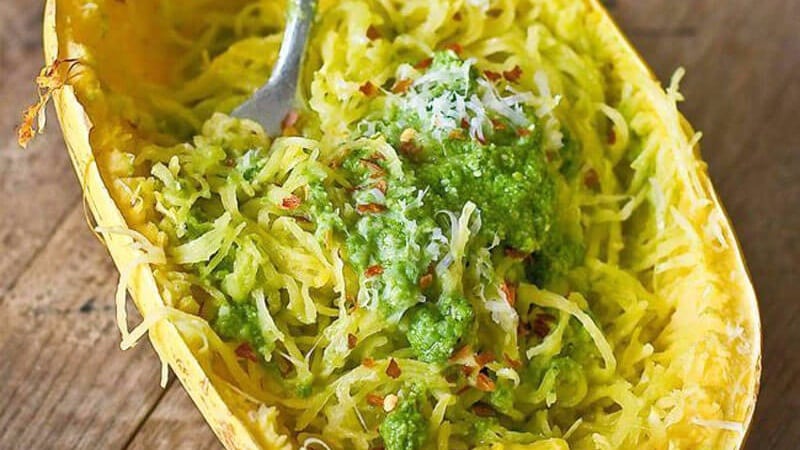
Farmer reviews
Absolutely all gardeners are attracted to this variety by the unusual structure of the fruit pulp. In addition, Spaghetti is considered the leader among other pumpkin varieties in terms of nutrient content.
Vegetable growers claim that the Spaghetti variety is unpretentious and does not require special care when growing it. The main activities are pinching the side shoots and the main stem, watering and weeding. Experienced farmers advise cutting young pumpkin fruits more often so that a new ovary appears faster.
Ekaterina, Chelyabinsk: “A hard-barked, short-climbing (well, at least I had one) pumpkin. Tasty, keeps well. This is essentially a long-lasting zucchini that breaks down into fibers. Therefore, don’t expect orange sweet pulp. The taste is neutral. The pulp is light yellow, transparent. This is the second year I’ve been planting with seeds purchased at the store.”
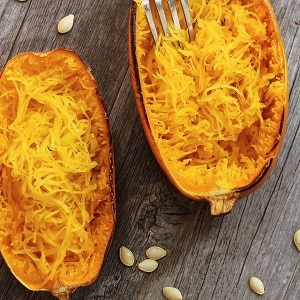 Anna, G. Novosibirsk: “I chose the Spaghetti variety after reading the description on the seed package: tender spaghetti-shaped pulp, with the aroma of vanilla, is a thick-skinned variety, which means it can be stored for a long time. I planted only two seeds for seedlings at the end of April, and after some time the seedlings reached impressive sizes.
Anna, G. Novosibirsk: “I chose the Spaghetti variety after reading the description on the seed package: tender spaghetti-shaped pulp, with the aroma of vanilla, is a thick-skinned variety, which means it can be stored for a long time. I planted only two seeds for seedlings at the end of April, and after some time the seedlings reached impressive sizes.
And I planted fully mature and strong seedlings in open ground on the twentieth of May. Because of the heat, only the male flowers bloomed for a long time, but by mid-July my pumpkins were starting to bloom. Since this variety is a short-climbing variety, the bush did not creep into neighboring plantings. And from mid-August I began to harvest.”
Conclusion
Spaghetti pumpkin is a godsend for the gardener. Even a beginner can grow this unusual vegetable in open ground. And dishes prepared from it are suitable for everyone, including people on a diet. In addition to the high content of nutrients, this pumpkin contains only 25 kcal per 100 g of weight.